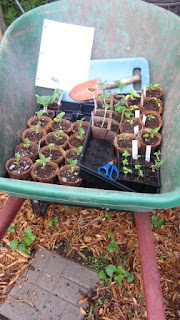Your seedlings that you started indoors are looking good and
you are ready to plant them in the garden.
So you are thinking you will just take them outdoors and plant them
directly in the garden right? Not
exactly. Remember these seedlings were
germinated indoors and are not acclimated to the outdoors just yet. So you have one more step to go through
before planting.
 |
| Cucumber, Eggplant, Squash, Basil, Zinnia, Tomato & Pepper Seedlings |
Hardening off is a process of slowly taking your seeds
outdoors and allowing them to adjust to their new environment. During this process plant growth slows and
more food is stored internally in the plants increasing the thickness of their
outer leaf layers.
I like to think of it like this: my seedlings are still
babies and need extra care and attention.
They are still vulnerable to the harsh sun and the changes in
temperature. Up to this point they have
been in my home in a controlled environment with the same amount of light and a
relatively predictable temperature. It is
now my job to help them adjust to the outside changes before they are planted
so that they can survive.
 |
| Seedlings beginning the hardening off process in the shade |
Here is how I went about hardening off our seedlings:
 |
| May 15th- First day I set out seedlings labeled as tender (see chart below) |
DAY 1: Find a
protected/covered area and set your seedlings under this area for 1 hour. Then
return them to your indoor seed starting area (ours is under lights in the
basement).
DAY 2: Same process but leave them out for 2 to 3 hours.
DAY 3: Same process
but leave them out for 4 hours.*
DAY 4: Same process
but leave them out for 5 hours.*
DAY 5: Same process
but leave them out for 6 hours.*
DAY 6: Same process
but leave them out for 7 hours.*
DAY 7: Same process
but leave them out for 8 hours.*
DAY 8: Let plants
spend the night outdoors under the covered/protected area.
DAY 9 thru 14: Gradually increase the amount of time the
seedlings are spending in the sun.
*you can also gradually introduce the sun (starting on day
3) in the morning light for about 1 hour then pull them back to the shade for
the rest of the time.
(This process will take a least 7 days but could go on for
up to 10 days depending on your specific zone).
I choose to just do this process for 8 days, but the closer
you go to 10 days the better the chances of your plants surviving the
transplant process. Above all make sure you don't skip this hardening off process. You worked hard to take care of your seedlings and it would be very disappointing to loose them at this point!
NOTE: Be aware of the
weather and temperature outside during this process. (See chart below) If the
temperatures are going to drop lower than the minimum temperature recommended
for your crop bring them indoors.
Recommended Minimum
Temperatures
Hardy
|
40 degrees F
|
Broccoli, Cabbage, Onions, Leeks, Parsley
|
Half-Hardy
|
45 degrees F
|
Celery, Lettuce
|
Tender
|
50 degrees F
|
Pumpkin, Squash, Sweet Corn
|
Tender
|
60 degrees F
|
Cucumber, Muskmelon
|
Tender
|
65 degrees F
|
Basil, Peppers, Tomatoes
|




 ro
ro












































